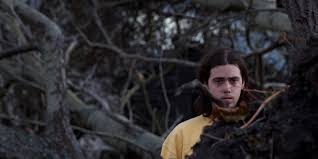The stereotype of Canadian film is that it situates itself in the periphery; all the more with the Maritimes. Goin’ Down the Road may be the regional summary: a story about two Nova Scotians migrating to Ontario for work, enshrined as a sociological snapshot of the era.
In an era of Reddit, Overwatch, and Netflix binges, however, the tenor of suburban hopelessness is different. Set in a dilapidated Cape Breton, Mass For Shut-Ins is focused on the day-to-day of jobless Kay Jay, a 25 year old who lives on his grandfather Lopper’s couch. Mass For Shut-Ins is as much about a comatose state of masculine-geekdom as it is about industrial deracination and the economic collapse of post-coal Cape Breton; as much about the aesthetics of Weird Twitter and Vice photoshoots as it is the succor of low-rent hedonism: sleeping-in, drinking a litre of soda a day, watching movies until you pass out.
The tremendous achievement of Mass For Shut-Ins is that it supersedes comparison to American precedents. Depicting Canada’s white underclass, critical comparisons to the work of Harmony Korine could be made. But the surreal emotional landscapes of Gus Van Sant might be more appropriate. At a Q&A after Mass For Shut-Ins’ debut, director Winston DeGiobbi said he admires films which immerse themselves in the debauchery depicted, rather than assume an objective distance. Mass For Shut-Ins’ leering is informed by a empathy for the pitiful circumstances it depicts.
Mass for Shut-Ins TRAILER from Winston DeGiobbi on Vimeo.
Shot predominantly in close-up, on grainy film, lingering on bodies, faces, appliances, and other Cape Breton ephemera, Mass For Shut-Ins is a film filled with empty highways and unadorned apartments. Flesh is sun-worn or peach-pale. Kay Jay’s hustling brother listens to horrorcore beats, cruising with his brother from the bottle depot. Kay Jay is the sole attendant at a kitschy church funeral, while a web-like portal on-screen depicts young women fawning over a pup. This is a movie about aching sustains. It makes an erect penis sliding out of boxers as a man sleeps in on a weekday pathetic and bathetic: a moment of quotidian oddity and beauty, comic waste and bodily sadness.
Mass For Shut-In’s debut at the Vancouver International Film Festival was preceded by the short-film There Lived the Colliers, by fellow Nova Scotian director Nelson MacDonald. A montage of project duplexes built in Cape Breton for the colliers (or coal miners) who worked in the area set to hypnagogic tape loops, There Lived the Colliers is similarly simmering and dulled, bludgeoned with its comatose environs, in a critique of a dead-end capitalism which builds-up communities and then abandons them. Houses, occupied or otherwise, sit in various states of disrepair and decrepitude. Often half of the duplexes are complete: a silly slanted slash next to an overgrown field of weeds.
The wear of the material world is always adjacent to the Canadian consciousness, as responsible for wealth as it is for shame. Documentation from DeGiobbi and MacDonald, tuned into forward thinking aesthetics, signal a new East Coast milieu that is worth paying attention to. Ambient loops are the sound of contemporary hauntology: paeans for past moments when other futures seemed possible. But the well is dry. DeGiobbi and MacDonald’s hypnagogia signal the need to rouse, still deferred.


